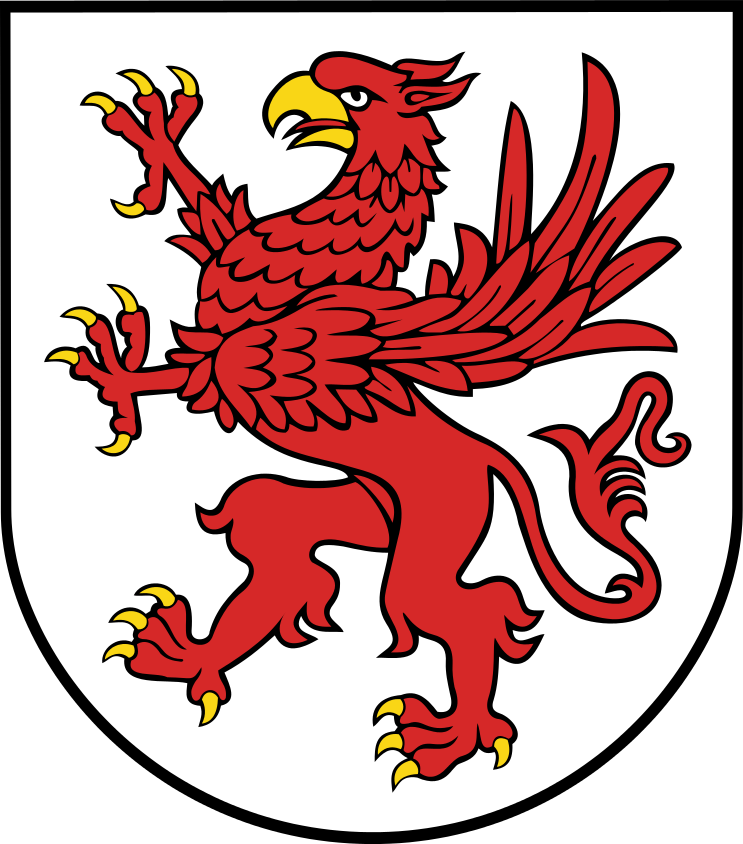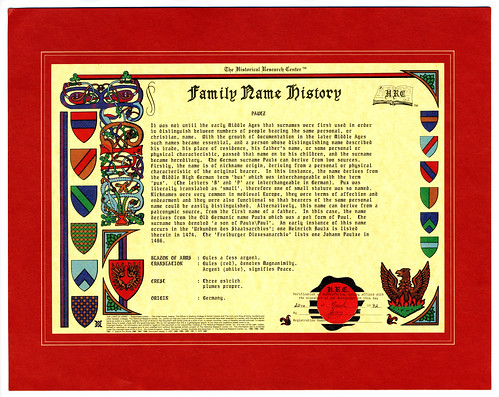the issue:
"The ancient Romans used similar insignia on their shields, but these identified military units rather than individuals. The first evidence of medieval coats of arms is found in the 11th century Bayeux Tapestry in which some of the combatants carry shields painted with crosses. Coats of arms came into general use by feudal lords and knights in battle in the 12th century. By the 13th century, arms had spread beyond their initial battlefield use to become a flag or emblem for families in the higher social classes of Europe, inherited from one generation to the next. Exactly who had a right to use arms, by law or social convention, varied to some degree between countries. In the GERMAN-SPEAKING regions both the aristocracy and "burghers" (non-noble free citizens) used arms, while in most of the rest of Europe they were limited to the aristocracy. The use of arms spread to the clergy, to towns as civic identifiers, and to royally chartered organizations such as universities and trading companies. Flags developed from coats of arms, and the arts of vexillology and heraldry are closely related. The coats of arms granted to commercial companies are a major source of the modern logo."
I have not been able to varify that in the German-speaking regions, regular free "burghers" (citizens, of a town) also used coats of arms, but the idea is an interesting one. All of the Pautz settlers to British Kaffraria (now the Eastern Cape of South Africa) in the 1850's were "Tagelöhner" (Tageloehner) or "day labourers" - the lowest standing in a predominantly agricultural society. But interestingly enough, tagelöhner were free. While the estate labourer on the vast estates, on the whole belonging to titled gentry (and had to get the landlord's permission for every move he wanted to make - "May I marry this girl?" for example), the Tagelöhner, although very poor, was master of his own destiny. This is not worth much if one has not the means to fulfil plans and dreams, but if a Tagelöhner could scrape together the money for the fare to Africa or America, he was free to go. On the other hand, the farmhand, employed by a landlord, and more often than not living in a "tied cottage" (the house goes with the job), had to ask permission to leave. As this was not easily given, many emigrants had to abscond and could only breath a sigh of relief once they were on the ship and sails were set.
So our South African progenitor, Karl August Ferdinand Gottlieb Pautz, was a free man, and MAY have had a Blazon of Arms. However, In my four decades of research through achive material in South Africa, Poland and Germany, I have never seen evidence of this, and have no first-hand (or anecdotal) family references to Arms. So I still doubt whether the family actually has its own Blazon.
The South African Pautzes originated from the towns of Wisbu and Woldenburg in Landkreis Regenwalde in Hinterpommern. Regenwalde was owned by nobility, namely the old Pomeranian family, the von der Ostens, who themselves have an interesting history.
I've been lucky enough to visit the area and the villages a number of times, and it's a beautiful, rural environment with a fascinating (and somethimes tragic) history. Over the past two decades, I have aquired a number of old maps and documents from Hinterpommern and Landkreis Regenwalde which reveal that the most common symbol of Pomerania is the Griffin, so I'd expect there to be a Griffin in the Pautz coat of arms, if it existed.
On my honeymoon in Scotland in 1995, at Loch Ness, I fell into a tourist trap and bought a Pautz Blazon of Arms from a company that claimed to have it on file (Heraldic Art and Design, 36 Swanston Avenue, Inverness, IV3 6QW, Scotland - I've searched, but don't think they exist anymore). They sent it to me in South Africa and this is it...
Utterly boring, seems to be generic, and there's not a Griffin in sight!
Nevertheless, the scroll itself was fairly nice - the artwork was hand painted and the caligraphy, pleasing on the eye...
The accompanying text was interesting:
"The surname Pautz is of Polish origin, though ultimately derived from the ancient Wendish word "pust", Polish "pusty", signifying "swamp, fen" and thus was first applied to a resident in or by such a spot. The place name Bautzen, where a related Slavonic language was spoken until the middle of the eighteenth century, is from the same root and may, in fact, sometimes have given rise to the surname."
By all accounts the family motto is "Pro Patria" (i.e. "for my country") - very ironic, as that was the name of the medal awarded to those of us who fought in the "Border War" in Northern Namibia and Angola in the 1970's. As I said - interesting - but there are no sources or references provived for this information, so someone in Aberdeen could have just sucked it out of his or her thumb!
Back in Pretoria in 1992 I also bought this (cheap, dot-matrix-printed) document from one of those guys in shopping malls. It probably has even less validity than the hard-written and -painted Aberdeen scroll, but here it is for completeness.
It's most likely a load of concocted nonsense (i.e. once again no sources of references cited) but here's the interesting, but probably generic, bit of the text:
"The German surname Pautz can derive from two sources. Firstly, the name is of nickname origin, deriving from a personal or physical characteristic of the original bearer. In this instance, the name derives from the Middle Hight German term "buz" which was interchangeable with the term "puz" (The letters "B" and "P" are interchangeable in German). Puz was literally translated as "small", therefore one of small stature was so named. Nicknames were very common in medieval Europe, they were terms of affection and endearment and they were also functional so that bearers of the same personal name could be easily distinguished. Alternatively, this name can derive from a patronymic source, from the first name of the father. In this case, the name derives from the Old Germanic name Pautz which was a pet form of Paul. The surname was thus denoted as "a son of Paul\Pautz". An early instance of this name occurs in the "Urkunden des Staatsarchivus": one Heinrich Bautz is listed therein in 1474. The "Freiburger Diozesanarchiv" lists one Johann Pautze in 1486."
So - there it is, for what it's worth! Personally, I remain very sceptical about the validity and reliability of the information presented in the two documents, but will continue to hunt for supporting evidence. Hey - at some stage I may formally lodge a coat of arms with the official registry here in the UK, but will certainly get professional heraldic input (and broad family consensus) before doing so!
Cheers, MAlfaRK ©




